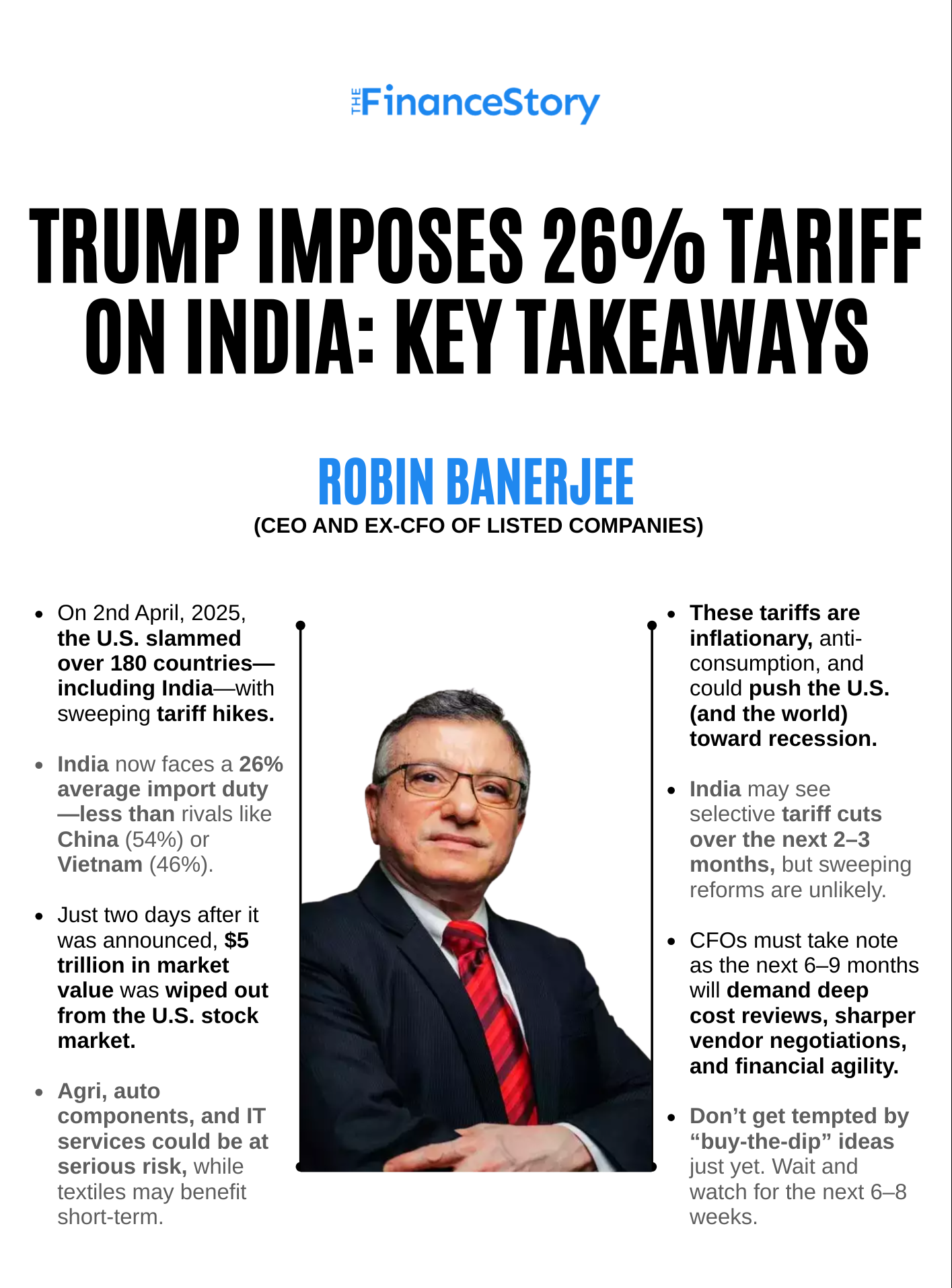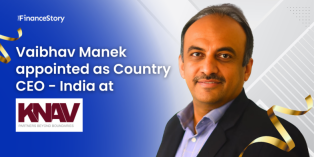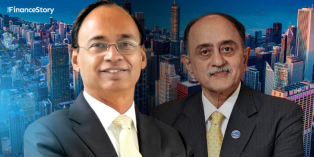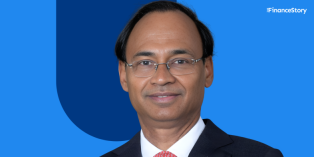- On April 2, America slapped over 180 countries with massive tariff hikes—some soaring to 54%.
- Indian exports now face a 26% tariff—lower than China or Vietnam, but still a major hit.
- Could it all snowball into a modern-day Great Depression?
- To unpack what this means for India, we sat down with Robin Banerjee, seasoned CEO, CFO for a no-nonsense breakdown.

The “Why” behind America’s tariff play?
For 80 years—since World War II—America positioned itself as the world’s policeman, promoting openness, democracy, and global collaboration.
And it worked!
This approach made America the richest country in the world, sitting on a $29 trillion GDP out of the $105 trillion global GDP.
But now? He has made a drastic pivot: “We exist for ourselves.”
Trump has long believed in import substitution — He’s going full America First. Again.
- Bring back U.S. manufacturing
- Kill cheap imports
- Tariffs, tariffs, tariffs
His campaign platform? “Make America Great Again” via tariffs. And it worked — the masses cheered.
What we saw on April 2 was a tectonic shift.
The world thought he was bluffing, but he wasn’t.

Why didn’t Trump focus on tariffs in his first term?
Trump 1.0 was his trial run. He wasn’t sure if the people truly backed him.
But after returning, he ran on a clear campaign message: “I will increase tariffs. I will bring back American manufacturing. I will make America great again.”
And the public—especially those not deeply educated in economics—bought into it.
They thought, “Why not make everything here? Why let others produce for us?”
So he got votes and power, and now he’s executing on what he’s always believed in.
It’s not about economics anymore, it’s about sticking to the campaign script.
What is happening in America as Trump imposes tariffs? What’s the good and the ugly?
Let’s be honest—I’m still looking for the “good.”
The only upside – In theory, high tariffs mean more domestic manufacturing!
But here’s the ugly:
- Average US import duty was 3%. Now it’s jumping to 25%.
- A $100 imported good now costs $125. That leads to immediate inflation.
- Consumption drops → Manufacturing drops → Employment drops → Recession begins.
Just look at what happened immediately after April 2.
In two days (April 3rd and 4th),—$5 trillion has been wiped out from the U.S. stock market, a massive drop from America’s total $32 trillion market cap.
This move is recessionary, anti-consumption, and inflationary.
And I have yet to meet a single economist who supports it.
Also read: Trump’s re-election! How will the Indian economy be impacted?
Can Trump roll back these tariffs once he sees the damage?
Short-term? 100% yes.
Take textiles—India’s top competitors are Bangladesh, Sri Lanka, and Vietnam.
Now, Vietnam just got hit with a 44% import duty.
But guess what? Just yesterday, the President of Vietnam told the U.S.: “Mr. America, export whatever you want—we’ll charge zero duty.”
So, Trump might say, “Okay, Vietnam’s playing ball, let’s cut their duty.”
This will start a domino effect.
Over 180 countries are affected by these tariffs.
Each one will now sit at their drawing board, asking: “What can we offer in return?” That includes India.
Trump’s been very clear: “You reduce, I reduce.”
This is deal-making mode. So yes, we could see short-term corrections very soon, depending on how countries respond.
Long-term? I don’t think the U.S. will tolerate this for long.
Look—America is rich, smart, and successful. But it won’t put up with economic self-harm forever. If this triggers inflation, a recession, or job losses, the pressure to reverse course will be massive.
So yes—short-term corrections are likely. And if this mess drags on, I believe a major rollback of the tariff decisions is coming.
Impact of Trump tariffs on India 2025?
India is now tariffed at 26%…Not great, but better than others.
- China: 54% (34% + the existing 20% rate Trump had already imposed against it in the initial weeks of his administration.)
- Vietnam: 46%
- Sri Lanka: 44%
- Bangladesh: 37%
- Japan: 24%
- Europe: ~20%
On a side note—India is lucky.
I think it should’ve been higher, maybe 34–35%, but I won’t argue if the U.S. wants to be kind!
Trump’s tariffs have hit the world’s second-largest economy, China, the hardest.
Mexico has been a top beneficiary!
Which Indian sectors are worst hit by Trump’s 2025 tariffs?
|
Product |
Previous Tariff |
New Tariff |
Impact |
|---|---|---|---|
|
Textiles |
3% |
26% |
Moderate gain |
|
Auto Components |
5% |
25% |
Severe hit |
|
Pharma |
0% |
0% (for now) |
Stable |
|
Agri (e.g. shrimp, rice) |
2% |
26% |
Negative |
|
SaaS / IT Services |
NA |
NA |
Indirect impact via slowdown |
Textiles & Apparel
- This is a positive for India.
- Competitors like Bangladesh (37%) and Sri Lanka (44%) face higher tariffs. US importers like Walmart may shift more sourcing to India.
- However, Turkey and Brazil, key competitors of India that face a lower 10% tariff, make them more attractive for US buyers!
Agri Products
- Agri exports like shrimp, non-basmati rice, and spices now face a 26% U.S. tariff. With the U.S. being a $5B+ buyer, this puts serious pressure on Indian exporters.
- These sectors are already operating at slim margins—any additional cost could push them into losses or force mass renegotiations.
- U.S. buyers may shift to South America, where tariffs are lower and supply chains are already strong.
IT & Software
- No tariffs on software? True. But if the U.S. goes into recession, the IT and SaaS spending shrinks.
- Companies will cut discretionary tech budgets, slow down digital transformation projects, and push out new contracts.
Auto Components
- Indian suppliers to U.S. auto giants like Ford or Tesla are now hit with a 25% tariff.
- Auto components are not easy to replace, but the cost dynamics just got uglier.
- Unless they absorb part of the tariff or renegotiate contracts, India may start losing out to Mexico or local U.S. suppliers.
Pharma
- Currently exempt.
- But Trump has hinted at “a bigger story for pharma.” We hope that’s just talk.
Also read: U.S. has threatened fresh reciprocal tariffs on Indian goods
Can India go all-in and slash tariffs?
Remember—India is a democracy.
Import duties can’t just be slashed because Piyush Goyal visits Washington or because PM Modi says so.
It needs legal approval—it must pass through Parliament.
That takes time.
That said, India’s already made some quiet moves in the last Budget:
✅ Bourbon whiskey import duty cut from 150% to 100%
✅ Motorcycles (like Harleys) cut from 60% to 30%
So it’s started—but is it enough? Probably not.
The U.S. claims that its weighted average import duty from India is 54%. That’s a big number—maybe inflated, but still big.
So what’s next? The Monsoon Session of Parliament is just three months away. And the Indian government has already said they’re actively negotiating tariff adjustments.
Expect India to lower some duties over the next 2–3 months, especially in high-value sectors.
(The agri sector is heavily protected—and 60% of India’s population depends on it. Cutting agri tariffs is politically sensitive and economically risky.)
So yes, India has to play the game. But we’ll have to do it strategically, not emotionally.
If India agrees to cut tariffs for the U.S., will other countries also demand similar concessions?
Absolutely.
The US has now opened the floodgates for bilateral negotiations.
India will need to juggle multiple conversations:
- US
- UK (already in advanced FTA talks)
- EU
- Australia
Will there be an across-the-board tariff cut? Unlikely. But we’ll see selective bilateral reductions, at least until the next budget.
The Commerce Ministry is very active right now.
The government needs time to assess the impact of these selective moves.
On the ground reality of the US tariff impact?
It’s only been a few days since April 2.
The next six months will be a grind.
But here’s the reality:
- The U.S. will continue buying food, textiles, fish, eggs—you name it. They’ll push for discounts. If they ask for 20% off, we might settle at 10%, because alternatives like China or Vietnam are even pricier.
- Many small and mid-sized exporters don’t have the luxury of saying “take it or leave it.”
- If U.S. buyers demand 20% price cuts, they’ll have to comply—or lose the client.
- Those already operating on razor-thin margins—say 5–6%—could go down to zero. Or worse.
So, CFOs must drill deep into cost structures, optimize wherever possible, negotiate smarter, and prepare for temporary hits.
EY and Fortune say Trump’s tariffs could fundamentally reshape India’s export strategy. Why?
To stay competitive, we’ll need to bring costs down dramatically.
That means real improvements in ease of doing business. If we want to manufacture at scale and stay cost-effective, bureaucracy must go.
Starting a factory or getting clearances should be as easy as it is in Singapore or Hong Kong.
Only then can India stay globally competitive and respond to these tariff shocks.
And what about the stock market—should we invest or stay out?
Trump’s move is recessionary. The global economy—not just India—will be impacted.
Here’s my advice:
- Diversify: People will move from equity to gold, crypto (though risky), and debt.
- Continue SIPs, but maybe reduce the monthly outflow and extend the timeline.
- Protect cash: Don’t get tempted by “buy-the-dip” ideas just yet. Wait and watch for the next 6–8 weeks. The U.S. is bleeding $2–3 trillion daily. This can’t go on for long. Trump will have to act—but how, nobody knows.
Also read: Deloitte U.S lost 129 federal contracts worth $372 Million
Has this ever happened before? What does history tell us about tariffs?
Yes! It happened 95 years ago.
In 1930, the Smoot-Hawley Tariff Act raised import duties from 5–6% to 20% on 20,000 items.
The president at the time, Herbert Hoover, approved it.
What followed? The Great Depression (1930–1934).
GDP fell, trade collapsed, and unemployment soared. It’s widely believed that the tariffs accelerated and deepened the economic crisis.
By December 2024, the average tariff had dropped to 3%. Now, in 2025, it’s jumping back to 25%.
History has shown this ends badly. Yet here we are—not learning from it.
“We’re seeing history dangerously close to repeating itself — and we’re ignoring its lessons.”
Anything else you’d like to add for CFOs in India?
Yes—stay informed. Don’t just follow WhatsApp forwards. Follow global sources—The Economist, Financial Times, New York Times, Reuters.
Watch what Trump’s team says—not just him. If his economists sound worried, that’s your signal a course correction may be coming.
Bottom line: Stay calm. Watch closely. Adjust your strategy. Keep cash ready. Slow down on equities. And above all—don’t panic.














